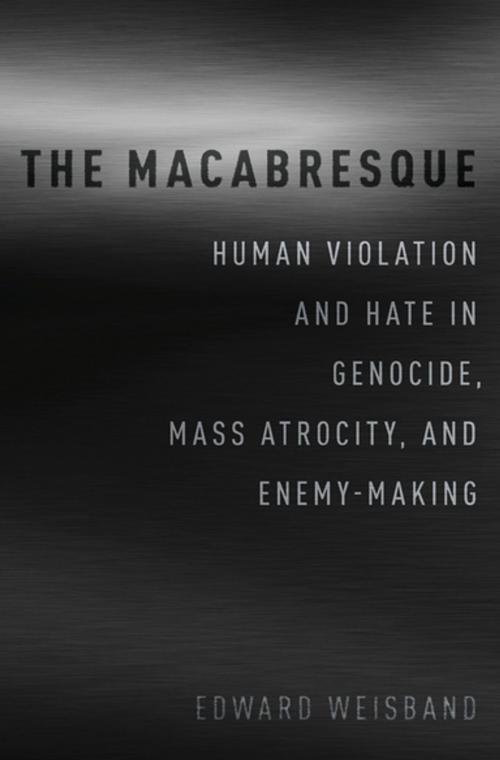The Macabresque
Human Violation and Hate in Genocide, Mass Atrocity and Enemy-Making
Nonfiction, Health & Well Being, Psychology, Social Psychology, Social & Cultural Studies, Political Science, Politics, History & Theory| Author: | Edward Weisband | ISBN: | 9780190677909 |
| Publisher: | Oxford University Press | Publication: | October 5, 2017 |
| Imprint: | Oxford University Press | Language: | English |
| Author: | Edward Weisband |
| ISBN: | 9780190677909 |
| Publisher: | Oxford University Press |
| Publication: | October 5, 2017 |
| Imprint: | Oxford University Press |
| Language: | English |
Studies of genocide and mass atrocity most often focus on their causes and consequences, their aims and effects, and the number of people killed. But the question remains, if the main goal is death, then why is torture necessary? This book argues that genocide and mass atrocity are committed not as an end in themselves but as a means to pursue sustained and systemic torture -- the spectacle of violence -- against its victims. Extermination is not the only, or even the primary, goal of genocidal campaigns. In The Macabresque, Edward Weisband looks at different episodes of mass violence (Chinese Cultural Revolution, the Holocaust, post-Ottoman Turkey, Cambodia, Rwanda, and Bosnia, among other instances) to consider why different methods of violence were used in each and how they related to the particular cultural milieu in which they were perpetrated. He asserts that it is not accidental that certain images capture our memory as emblematic of specific genocides or mass atrocities (the death marches of the Armenian genocide, mass starvation in the Ukraine, the killing apparatus and laboratories of the Holocaust, the killing fields of Cambodia) because such violence assumes a kind of style each time and place it arises. Weisband looks at these variations in terms of their aesthetic or dramaturgical style, or what he calls the macabresque. The macabresque is ever present in genocide and mass atrocity across time, place and episode. Beyond the horrors of lethality, it is the defining feature of concentration and/or death camps, detention centers, prisons, ghettos, killing fields, and the houses, schools and hospitals converted into hubs for torture. Macabresque dramaturgy also assumes many aesthetic forms, all designed to inflict hideous pain and humiliating punishments, sometimes in controlled environments, but also during frenzied moments of staged public horror. These kinds of performative violations permit perpetrators to revel in their absolute power but simultaneously to project hatred, revenge and revulsion onto victims, who embody the shame, humiliation and loss felt by their torturers. By understanding how and why mass violence occurs and the reasons for its variations, The Macabresque aims to explain why so many seemingly normal or "ordinary" people participate in mass atrocity across cultures and why such egregious violence occurs repeatedly through history.
Studies of genocide and mass atrocity most often focus on their causes and consequences, their aims and effects, and the number of people killed. But the question remains, if the main goal is death, then why is torture necessary? This book argues that genocide and mass atrocity are committed not as an end in themselves but as a means to pursue sustained and systemic torture -- the spectacle of violence -- against its victims. Extermination is not the only, or even the primary, goal of genocidal campaigns. In The Macabresque, Edward Weisband looks at different episodes of mass violence (Chinese Cultural Revolution, the Holocaust, post-Ottoman Turkey, Cambodia, Rwanda, and Bosnia, among other instances) to consider why different methods of violence were used in each and how they related to the particular cultural milieu in which they were perpetrated. He asserts that it is not accidental that certain images capture our memory as emblematic of specific genocides or mass atrocities (the death marches of the Armenian genocide, mass starvation in the Ukraine, the killing apparatus and laboratories of the Holocaust, the killing fields of Cambodia) because such violence assumes a kind of style each time and place it arises. Weisband looks at these variations in terms of their aesthetic or dramaturgical style, or what he calls the macabresque. The macabresque is ever present in genocide and mass atrocity across time, place and episode. Beyond the horrors of lethality, it is the defining feature of concentration and/or death camps, detention centers, prisons, ghettos, killing fields, and the houses, schools and hospitals converted into hubs for torture. Macabresque dramaturgy also assumes many aesthetic forms, all designed to inflict hideous pain and humiliating punishments, sometimes in controlled environments, but also during frenzied moments of staged public horror. These kinds of performative violations permit perpetrators to revel in their absolute power but simultaneously to project hatred, revenge and revulsion onto victims, who embody the shame, humiliation and loss felt by their torturers. By understanding how and why mass violence occurs and the reasons for its variations, The Macabresque aims to explain why so many seemingly normal or "ordinary" people participate in mass atrocity across cultures and why such egregious violence occurs repeatedly through history.















